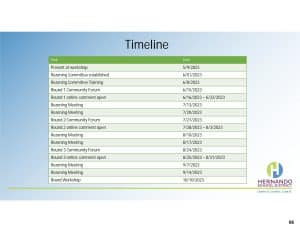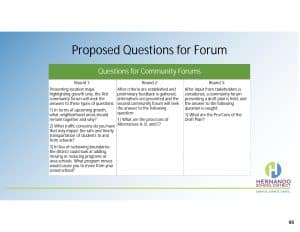District officials review school rezoning process details
At the May 9th School Board Workshop, the School District (HCSD) heard a proposed process that will lead the board and staff through school rezoning for the 2024-25 school year. The last school rezoning took place over the 2015-16 school year.
Sophia Watson, Director of Simpson Tech, and James Lipsey, manager of planning, growth, and construction for HCSD presented the suggested process, which highlights transparent communication with the community while addressing challenges brought forth by the county’s steep population growth curve.
The purpose of school rezoning is to reduce overcrowding, maximize efficiency, and minimize the impact on students – the most important goal. Utilization of facilities and transportation are other factors considered. Watson suggested the board should use this time of preparation to consider the relocation of special programs between schools and future construction. The board will weigh options of new school construction, and expansion of existing schools.
According to Lipsey, the Department of Education (DOE) recommends that school districts should balance current and projected student enrollment with school capacity before building new schools. “It’s a fiscally responsible way to avoid overcrowding before spending capital dollars on schools. It means adjusting school attendance boundaries in order to reassign some of the student population in high-growth areas to schools that have room for them.
The proposed process sets three phases, or rounds, beginning with information gathering from the community on traffic patterns, neighborhoods, any bottlenecks that may occur, and any unsafe road hazards that may need to be considered. In round two, a rezoning committee will present options based on feedback on information collected in round one. The third and final round will involve a final community forum, and the final recommendation will be submitted to HCSD for final approval.
Watson said of the community involvement, “It’s important for the rezoning process to hear our community, because sometimes on paper, its words … and then you drive through Explorer (for example) during release, and it’s a whole different world.” The timeline for the entire process begins with this workshop and concludes in October 2023.
A major difference between this and previous rezoning procedures is that School Choice and Magnet programs will be addressed. Lipsey said, “One of the things you’ll recall that we heard expressed fairly vehemently when we were looking at rezoning Winding Waters was that opportunities for Choice and Magnet were not taken into consideration. This schedule absolutely does take that into consideration.”
Lipsey said that the proposed timeline “coincides with the Magnet window for those families who feel that they may be negatively impacted by the boundary moves. The Choice window opens in January, so this will be in place well before that.” During this timeline, Lipsey reports that there will be opportunities for the community to express their concerns during a forum and online discussion. The board will be able to request an update at any time.
The proposed rezoning committee should consist of district staff, lead principals, and two community members appointed by each board member from their respective districts. Due to the impact on schools and teachers, HCTA (Hernando County Teachers Association) representation will also be involved.
Since there are a lot of moving parts to the process, the primary criteria that will be used during the process are geographic proximity, instructional capacity, and projected enrollment. GIS (Geographic Information System) mapping will assist in providing this Information.
Secondary criteria include traffic Patterns, magnet school programs, special programs and school feeder alignment. Watson sought direction from the board regarding which aspects they are allowed to look at.
Watson sought specific guidance on the transfer of magnet and special programs to other schools, “Are we allowed to consider moving special programs if they’ll help attract students to a less geographically convenient area?” An example of such a move is when JD Floyd Elementary’s environmental program was moved to West Hernando.
“I think you should keep everything on the table,” Chairman Gus Guadagnino said. Board Member Mark Johnson agrees, adding, “When you’re talking about traffic patterns, you would consider the changes that are going to occur over the summer.” Westside Elementary and Winding Waters K-8 are to have their pickup and release loops revised over the summer break. No information was available on the locations of projected new schools.
Lipsey reported that he will be giving a Planning and Growth recap on May 30th to begin identifying population remedies such as new school construction or adding capacity to existing schools.
Board Member Shannon Rodriguez added the possibility of designating existing schools as magnet schools. Currently, Nature Coast Technical High School is the only magnet school that also specifies a zone boundary for students not in the Magnet program – something the board may explore for Chocachatti or Challenger K-8.
Johnson requested Watson and Lipsey provide a review to the school board after each step in the timeline is completed. He also recommended that the committee hold forums in each phase, and hold forums in multiple sections of the county.
The forums will be officially noticed, recorded, and published in accordance with the State’s Sunshine laws. The board and committee will be able to receive public input from the District’s Let’s Talk app, as well as online comments during specified intervals.



